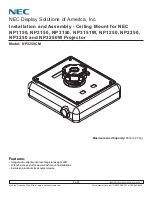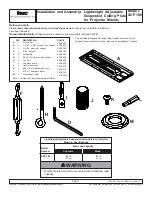
Minor Motion, Ultrasonic
Major Motion, Ultrasonic
Maximum coverage area may
vary somewhat according to room
shape and the presence of obstacles.
The NEMA WD 7 Guide and robotic
method were utilized to verify
coverage patterns.
24’
(7.3 mm)
Minor Motion, IR
Major Motion, IR
20’
(6 mm)
8’
(2.4 mm)
8’
(2.4 mm)
24’
(7.3 mm)
20’
(6 mm)
0
10 ft
(3 mm)
12’
(3.7)
12’
(3.7)
6 ft
(1.7 mm)
15 ft
(4.6 mm)
24 ft
(7.3 mm)
50 ft
(15.3 mm)
Installation Instructions
Model # OAWC-DT-120W
Model # OAWC-DT-120W-R
Dual Technology Wall/Corner Mounted Low
Voltage Occupancy Sensor
• Read all instructions on both sides of this sheet first
• Install in accordance with ALL local codes.
• For indoor use only.
• For Use with Greengate Switchpacks & Systems Only.
• Do not run any Greengate Low Voltage Wiring in the
same conduit as power conductors.
General Information
Cooper Controls
203 Cooper Circle, Peachtree City, GA 30269
800-553-3879
www.coopercontrol.com
Technology:
Passive Infrared (PIR) and Ultrasonic (US)
Power Requirements:
Input:
• 10-30 VDC from Greengate Switchpack or Greengate
system. Maximum current needed is 25mA per sensor
Output:
• Open collector output to switch up to ten Greengate
Switchpacks. BAS with Isolated Form C Relay (-R model)
Isolated Form C Relay Ratings: 1A 30VDC/VAC
Time Delays:
Self-Adjusting, 15 seconds/test
(10 min Auto), or Selectable 5, 15, 30 minutes
Coverage:
1200 sq. ft.
Light Level Sensing:
0 to 300 foot-candles (- R model)
Operating Environment:
• Temperature: 32° F – 104° F (0° C – 40° C)
• Relative Humidity: up to 90% non-condensing
Housing:
• Medium impact injection molded housing.
Polycarbonate resin complies with UL94V0.
Size:
4.4" x 3.4" x 2" (112mm x 86.4mm x 50.8mm)
LED Indicators:
Red indicates PIR detection; Green
indicates Ultrasonic detection
Specifications
Description
The OAWC-DT Wall/Corner Mount Low Voltage Occupancy Sensor is a Passive Infrared (PIR) and Ultrasonic (US) motion
sensing lighting control, used for energy savings and convenience. PIR is used to turn the lights ON and then either or both
technologies are used to keep the lights ON. When motion is detected, the blue wire is electronically connected to the red
wire, energizing the relay in the switchpack to turn on the load. If vacancy is detected, the blue wire is disconnected from the
red, causing the relay to open turning off the load. The red lead is 10-30 VDC supply, the black lead is common, and the blue is
the relay control.
The sensor includes self-adaptive technology that continually adjusts to conditions by adjusting sensitivity and time delay in
real-time.
The Daylighting feature (-R model only) prevents lights from turning ON when the room is adequately illuminated by natural light.
Walk-Through feature maximizes energy savings by not leaving the lights ON after momentary occupancy. The sensor will
switch the lights ON when it detects a person entering the area. If the sensor does not continue to detect motion 30 seconds
following the initial activation, it will automatically go to a shorter 2 minute time delay.
In Automatic ON Mode, the lights turn ON when a person enters the room. In Manual On Mode, the lights are turned ON
by activating a momentary switch (model # GMDS-*) that is connected to the sensor. When used with 2 level lighting (-R
model only), bi-level Automatic-on can be achieved which allows Zone 1 to come ON automatically upon occupancy. Zone 2
does not come ON unless the occupant presses the optional momentary switch.
Location
The maximum coverage area may vary somewhat according to room shape
and the presence of obstacles. Follow the coverage diagram concerning major
and minor motion coverage. Decrease total coverage area by 15% for “soft”
rooms (for example, heavy draperies or heavy carpeting). The sensor must have
a clear view of the area to be controlled. The sensor will not “see” through
glass. Mounting height should not exceed 12 feet. Optimum mounting height is
10 feet. Mount the sensor so the grilles face the open portion of the room and
are not facing a nearby wall, door, window, or other obstructing object. Avoid
pointing into hallways. To prevent false activation, the sensor should be mount-
ed away from the air supply duct a minimum of 4 to 6 feet. Mounting at fixture
height is most effective. For typical placement refer to Location Diagram.
Installation
The OAWC-DT-120W can be mounted to the wall, ceiling, junction box, or round fixture with raceway.
Wiring
CAUTION: Before installing or performing any service on a Greengate system, the power MUST be turned OFF at
the branch circuit breaker. According to NEC 240-83(d), if the branch circuit breaker is used as the main switch
for a fluorescent lighting circuit, the circuit breaker should be marked “SWD”. All installations should be in com-
pliance with the National Electric Code and all state and local codes.
NOTE REGARDING COMPACT FLUORESCENT LAMPS: The life of some compact fluorescent lamps (CFLs) is shortened
by frequent automatic or manual switching. Check with CFL and ballast manufacturer to determine the effects of cycling.
1. Make sure power is turned OFF at the branch circuit breaker.
2. Wire units as shown in wiring diagrams per applicable voltage requirements. (Use twist-on wire connectors
for all connections) CAP ALL UNUSED WIRE LEADS.
3. Mount unit to wall, ceiling, junction box, or round fixture with raceway.
4. Turn power back ON at the branch circuit breaker and wait 2 minutes for the unit to stabilize.
5. Make necessary adjustments. (See Checkout and Adjustments section)
Occupancy Sensor Mounted to Wallboard
Occupancy Sensor Mounted to Round Fixture with Raceway
Occupancy Sensor Mounted to Octagon Box
Occupancy Sensor Mounted to Drop Ceiling
Location Diagram
Coverage
Occupancy Sensor Mounted to Octagon Box with Mud Ring




















